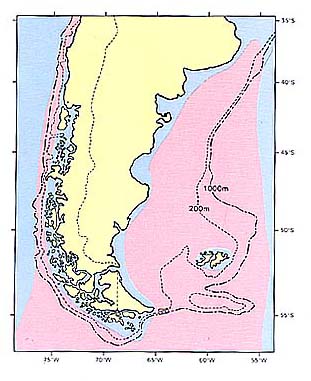クロタチカマス科
- HOME
- デジタル図鑑
- パタゴニア海域の重要水族
- 硬骨魚綱 スズキ目
- クロタチカマス科
クロタチカマス科(Gempylidae)

109 ホソナガクロタチ(Hosonaga-kurotachi)
Paradiplospinus gracilis (Brauer, 1906)
特 徴:
背鰭36~37棘,29~30軟条,臀鰭2棘,26~27軟条,胸鰭13軟条,鰓耙数6+1+22~23=29~30,鰓条骨数7.頭長は体長の18.8~19.6%,眼径は3.1~3.5%,体高は4.8~7.5%,吻長は8.4~8.7%,両眼間隔は2.2~2.6%,上顎長は8.4~8.5%,尾柄高は0.9~1.3%,胸鰭長は6.0~7.2%,第1背鰭高は5.1~5.4%,第2背鰭高は4.2~5.3%,臀鰭高は3.5~4.0%。体は著しく延長して,側扁し,体長は体高の14~17倍。頭は縦扁し,大きさは中庸で,体長は頭長の5.1~5.4倍。口は湾曲し,大きい。上顎後端は眼の前縁下に達する。上顎より下顎の方が前方に突出する。吻は長く,頭長は吻長の2.2~2.4倍。数本の牙状歯が上顎前端部に,一対の牙状歯が下顎前端部にそれぞれある。両顎側歯は1列に並ぶ鋭い数本の犬歯からなる。鋤骨は無歯。口蓋骨上に微小歯が1列に並ぶ。両鼻孔は相接近し,吻端より眼に近く位置する。前鼻孔は円形で周囲は管状,後鼻孔は三ヶ月形を呈する。眼は大きく,頭長は眼径の約5倍。両眼間隔域は平坦で狭く,吻長はその幅の約3倍。主鰓蓋骨後縁に顕著な欠刻がある。鰓耙は小棘状で,隅角部のものはT字型で,他のものよりやや大きい。擬鰓はよく発達する。第1背鰭基底長は第2背鰭基底長より大。臀鰭の前半部は後半部より高い。胸鰭は短く,その長さは吻長より短い。肛門は吻端と尾鰭後端の中間より前方に位置し,臀鰭第1棘より吻長にほぼ等しい距離だけ前方にある。側線は単線で,脱落し難い。
分 布:
南半球の温・寒帯海域,とくに寒帯海域に多い。
備 考:
Andriashev(1960)によって新たに記載されたParadiplospinus antarcticusは本種の異名と考えられる。
(中村 泉)
Material examined:
3 from Argentina (245.1-257.0 mm SL), FAKU AP 79, 80; S 623.
Description:
D ⅩⅩⅩⅥ-ⅩⅩⅩⅦ, 29-30; A Ⅱ, 26-27; P1 13; GR 6+1+22-23=29-30; BR 7.
HL 18.8-19.6% of SL; ED 3.1-3.5; BD 4.8-7.5; SN 8.4-8.7; IO 2.2-2.6; UJ 8.4-8.5; CP 0.9-1.3; P1L 6.0-7.2; D1H 5.1-5.4; D2H 4.2-5.3; AH 3.5-4.0.
Body elongate and compressed, body depth 14-17 times in SL. Head depressed, moderate in size, 5.1-5.4 times in SL. Snout long, 2.2-2.4 times in head. Mouth large and curved, posterior end of upper jaw reaching anterior margin of eye, lower jaw projected anterior to upper jaw. Several large fangs on anterior part of upper jaw, a pair of fangs on anterior part fo lower jew. Several sharp caniniform teeth uniserial on both jaws. No teeth on vomer, several fine teeth uniserial on palatines. Two nostrils situated close each other, nearer to anterior margin of eye than to tip of snout, anterior nostril circular with low tube around and posterior nostril crescent. Eye large, about 5 times in head. Interorbital region flat and narrow, its width about 3 times in snout length. A conspicuous notch on posterior margin of opercle. Gill-rakers minute spinescent, a raker on corner T-shaped, slightly larger than other rakers. Pseudobranchiae well developed. First dorsal fin base longer than second dorsal fin base. Anterior part of anal fin fairly high. Pectoral fin small, shorter than snout length. Pelvic fin reduced to a minute spine or completely absent. Position of anus nearer to tip of caudal fin than to tip of snout, and anterior to first anal spine by distance about equal to sonut length. Lateral line single and intact.
Distribution:
Temperate and especially cold waters of the Southern Hemisphere.
Remarks:
Paradiplospinus antarcticus from the Antarctic Sea, recently newly described by Andriashev (1960) seems to be a junior synonym of P. gracilis.
(Izumi NAKARURA)

Distribution of Paradiplospinus gracilis in Patagonia.

Lateral line. Scale (1) and canal (2).